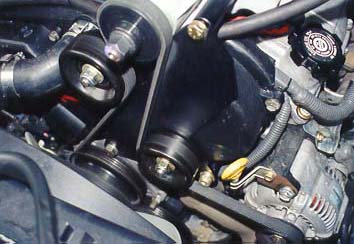
This
is the original pulley plate with the two idler pulleys.
The original TRD
supercharger kit came with a pulley plate that had two idler pulleys
to guide the drive belt. Very soon after the release of the
first batch problems started to surface with drive belts coming off
or failing. TRD as a fix modified the pulley plate so that it
only had one idler pulley. It is hard to believe, but fewer
guide pulleys seemed to work better.
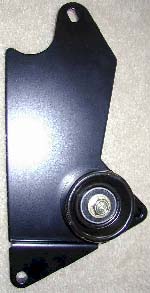
This
the later pulley plate with the single pulley
The problem was setting the
proper tension of the drive belt. The newer flat ribbed belts
require much higher tension then the old V belts to work
properly. There is a gauge called a belt tension gauge that
you should buy to properly set the belt tension, but they are
expensive and sell for around $100. Belt problems seemed to
always plague the supercharger because people just would not spend
the $100 for the proper tools and it seems that the dealers that are
supposed to have them many times don't. If the belt is to
loose it will slip, wear out faster, and may jump off the
pulleys. If it is to tight then it put excessive load on the
bearings in the supercharger nose drive, idler pulleys, and
alternator. There is a very fine line between to tight and to
loose, neither is a good thing.
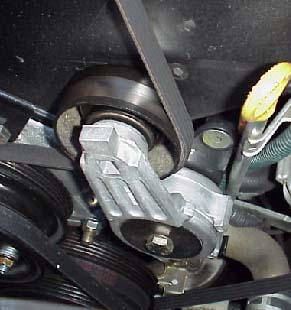
Here
is the new TRD "Dynamic Tensioner" installed.
The latest kits are now
including a spring loaded supercharger belt tensioner. The
tensioner is available as an upgrade for the older kits. In the past you needed to
obtain a belt tension gauge that can cost as much as $100 to properly
set the belt tension. In theory the new tensioner handles
this problem for you. However, the installation guide still says
that a belt tension gauge should be used to set the initial tension of
the belt. The alternator can be moved in and out to
adjust the belt tension on a stock engine and if it is to far in or
out it will prevent the new tensioner from holding the proper
tension so it must still be initially set using the gauge and from
then on it should be fine. I found that with both of
retrofit dynamic tensioners that I installed on my 4Runners I did
have to use the belt tension gauge to properly set the tension to 80
Lbs-Ft of tension. This was even with the tension properly set
with the pulley plate.
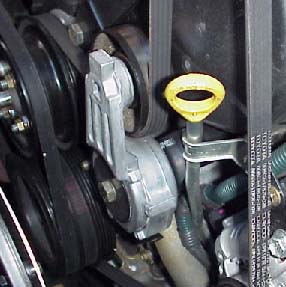
The
tensioner comes with two brackets, one if for relocating the
wire harness that is behind the tensioner, and the other is to
relocated
the oil dipstick tube. You will need a torque wrench to install
the tensioner.
I have obtained a retrofit
dynamic tensioner and installed it. It is a very nice unit,
however I think I see potentially a serious problem with it. On
the original kits a steel pulley plate was bolted to the engine block
and the nose of the supercharger. This served two purposes.
One it held the guide pulley or pulleys for the belt depending on
which version you have; and two it supported the nose of the
supercharger. This plate is removed with the dynamic tensioner
and now the nose is not supported. The belt puts a high load on
the nose of the supercharger along with the weight of the supercharger
assembly its self. The mounting points on the manifold are in
cast aluminum. The mounting point is a fair distance from the
load. It is a matter of leverage here. I am convinced that
the mounting points are not strong enough to carry this load and the
mounting bolts will eventually pull out of the cast aluminum.
The bolts are only torqued to 13 lb-ft to prevent them from stripping
so they can't be very strong.
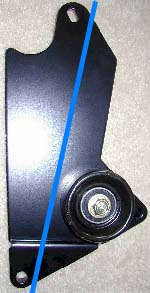
I
took my old single pulley plate and cut it along the line and
removed the pulley part.
This worked great for supporting the nose of the supercharger and
provide enough room
for the new dynamic tensioner pulley.
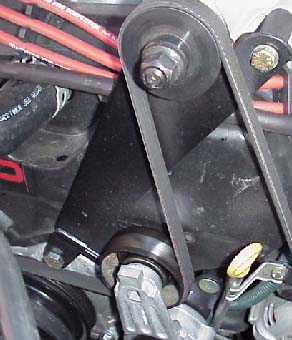
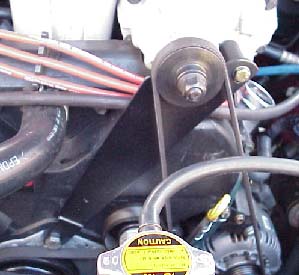
As
you can see in these pictures my modified bracket supports the
front of the supercharger nicely.
Out of concern for what I
believe to be a problem I cut up my old pulley plate so it will clear
the dynamic tensioner and installed it so that it still supports the
nose of the supercharger. This may or may not be a problem, but
I have always said "careful never hurt nobody."
The single pulley plate is
available from TRD through your local dealer. It is surprisingly
cheap for a TRD part and is much easier to get one and cut it then
to make your own supercharger support. You may want to act
fast because they may stop making and stocking them with the release
of the dynamic tensioner.
